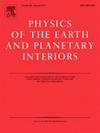Archaeointensity study of pottery from the Maya settlements of La Blanca and Chilonché (Petén, Guatemala): New data to constrain the geomagnetic field evolution in Central America
IF 1.9
3区 地球科学
Q2 GEOCHEMISTRY & GEOPHYSICS
引用次数: 0
Abstract
Accurate determination of the spatio-temporal variation of the geomagnetic field before direct measurements relies on reliable archaeomagnetic data. This study presents new archaeointensity data from Central America, a region with paucity of archaeomagnetic data. We specifically investigate 71 Maya pottery fragments collected at the “La Blanca” and “Chilonché” archaeological sites in Guatemala, with ages ranging between 600 and 1100 CE. We employed the classical Thellier-Thellier palaeointensity method, including partial thermoremanent magnetization (pTRM) checks, TRM anisotropy, and cooling rate corrections at the specimen level. Out of 252 specimens analyzed, only 50 from 14 fragments yielded successful results. The fragment-mean intensities obtained meet modern standards and are considered technically robust. Our findings indicate significant variability even among samples from the same period, likely due to age disparities among fragments, undetected issues in magnetic properties of the analyzed potteries and fluctuations in geomagnetic intensity. To better understand this variability, acquiring new data with higher precision dating, ideally at multi-decadal intervals, is essential. A comparison with selected previous palaeointensities, regional palaeosecular variation curves from Mexico, and global geomagnetic field models' predictions confirms that the current understanding of geomagnetic field strength evolution in Central America is unsatisfactory due to the low number of archaeomagnetic data and their significant dispersion. In this context, new high-quality palaeointensity data are required to serve as a constrain for establishing the geomagnetic field behavior in Central American during the first millennium CE and to contribute improving regional and global geomagnetic field reconstructions.

玛雅人在La Blanca和chilonch定居地的陶器考古强度研究:限制中美洲地磁场演化的新数据
在直接测量之前准确地确定地磁场的时空变化依赖于可靠的考古磁数据。这项研究提出了来自中美洲的新的考古强度数据,这是一个缺乏考古磁数据的地区。我们专门研究了在危地马拉“La Blanca”和“chilonch”考古遗址收集的71件玛雅陶器碎片,这些碎片的年龄在公元600年到1100年之间。我们采用经典的Thellier-Thellier古强度方法,包括部分热磁化(pTRM)检查,TRM各向异性和试样水平的冷却速率校正。在分析的252个标本中,14个碎片中只有50个获得了成功的结果。得到的碎片平均强度符合现代标准,在技术上被认为是鲁棒的。我们的研究结果表明,即使在同一时期的样品中,也存在显著的差异,这可能是由于碎片之间的年龄差异、分析陶器的磁性未被发现的问题以及地磁强度的波动。为了更好地理解这种变异性,必须以更高的精度获取新数据,最好是以几十年为间隔。通过与以往选定的古强度、墨西哥区域古长期变化曲线和全球地磁场模型预测的比较,证实了目前对中美洲地磁场强度演化的认识是不令人满意的,原因是考古磁资料数量少,且分布明显。在此背景下,需要新的高质量古强度数据作为建立公元第一个千年中美洲地磁场行为的约束条件,并有助于改进区域和全球地磁场重建。
本文章由计算机程序翻译,如有差异,请以英文原文为准。
求助全文
约1分钟内获得全文
求助全文
来源期刊

Physics of the Earth and Planetary Interiors
地学天文-地球化学与地球物理
CiteScore
5.00
自引率
4.30%
发文量
78
审稿时长
18.5 weeks
期刊介绍:
Launched in 1968 to fill the need for an international journal in the field of planetary physics, geodesy and geophysics, Physics of the Earth and Planetary Interiors has now grown to become important reading matter for all geophysicists. It is the only journal to be entirely devoted to the physical and chemical processes of planetary interiors.
Original research papers, review articles, short communications and book reviews are all published on a regular basis; and from time to time special issues of the journal are devoted to the publication of the proceedings of symposia and congresses which the editors feel will be of particular interest to the reader.
 求助内容:
求助内容: 应助结果提醒方式:
应助结果提醒方式:


